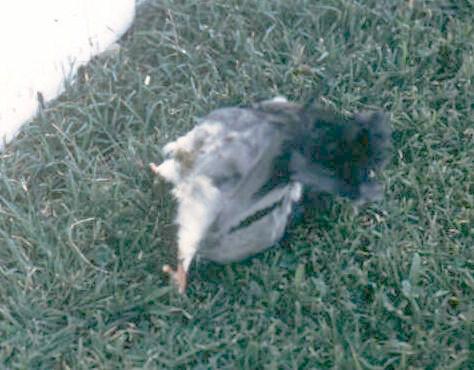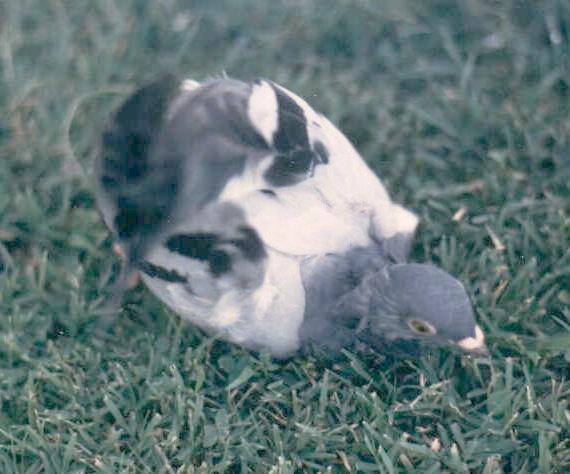
9. X-Pigeons |
||||
wo - Wobbly
The wobbly mutant was first documented by Robert. J. Mangile in 1988, “Wobbly"-Is it new in pigeons?” The article, “Three New Recessive Behavior Mutants in the Domestic Pigeon”, published in Behavior Genetics by Willard. F. Hollander and Robert. J. Mangile in 1994 also reported this uncoordinated behavior in pigeons.
The wobbly mutant was first reported by Eugene Hochlan Jr. of Council Bluffs, Iowa and assumed it was a genetic recessive trait. Hochlan noticed this mutant occasionally occurring in the "Chinese Owl" breed and gave it the name "wobbly." In 1984, he donated breeding stock to Mangile and also to Kerry Hendricks of West Bloomfield, Michigan, for further testing. Preliminary reports were published by Mangile (1988, 1990). Since then, a few fanciers have accumulated scanty breeding data which strongly suggest that "wobbly" is a simply recessive trait (gene) and the gene symbol was assigned "wo" for "wobbly" by Mangile.
According to Mangile’s preliminary report, wobbly squabs appeared normal; but, newly hatched squabs sometimes display unsteady heads. “At about two weeks of age a slight but extremely rapid head tremor may be noticed. The tremor is unique, in that it appears to rotate vertically and with such speed that in a few individuals the eyeball appears enlarged from the "after image" produced. At this stage the squab may or may not appear to walk and move normally. With advancing age (3-4 weeks) it becomes noticeably unsteady and "wobbles" when walking, sporadically jabbing its head forward and downward. The bird's condition appears to worsen until about two months of age, often falling over forward or backward when attempting to walk. Later, it stands with legs spread and its abdomen may touch the floor; sometimes bracing itself on its tail.
Judging from the degree of infertility it appears that cocks have difficulty copulating; and birds displaying an extreme expression of the "wobbly" trait may have difficulty eating and drinking, or maintaining an upright position. The ability to fly with control surprisingly, appears mostly normal over short distances within the confines of a loft; but landing under control is difficult. Most soon learn to select a nestbox or a favorite place where left unmolested. Birds displaying milder expressions of the trait function reasonably well; i.e., they fly to upper levels, eat and drink well, and in spite of their wobbly gait, mingle with loftmates. Vision seems to be unimpaired.
The reproductive potential of wobbly pigeons is difficult to assess from limited experience. The original hen laid and hatched eggs; but memory recalls that some were rough-shelled. She died from oviduct complications, under three years of age. Another hen died trying to lay her first egg; and, yet another hen reportedly died young after given to another fancier. Such cases might suggest that wobbly hens have trouble laying, and/or live short lives. The original hen did not generously feed squabs” (Mangile).
According to Mangile and Hollander, preliminary histological study of the brains of wobbly specimens by Dr. Lyle D. Miller of the Iowa State University College of Veterinary Medicine has revealed no obvious abnormality. They’ve concluded that there must be some disturbance of coordinating centers, involving mainly the posterior parts of the body; A number of wobbly females have died "egg-bound" (inability to expel an egg), an extremely rare problem in normals. Mangile and Hollander also suggested that the erratic and the crazy mutants appear to affect coordination mainly of the anterior part of the body, while the wobbly mutant affects coordination mainly of the posterior part.

Photographed from above while nearly standing on its head, this juvenile Wobbly cock displays one of many awkward positions so typical in extreme examples of "wobbly" pigeons. Notice wide spread feet and tail held up and forward above head. Photo by: Kerry Hendricks. This picture is taken from "Wobbly"-Is it new in pigeons? article written by R. J. Mangile.

Photographed from above the same "wobbly" Blue Bar Chinese Owl backcross, in a similar position. Such positions are achieved during excited or hurried attempts to move forward. Note the healthy physical condition of the bird. Photo by: Kerry Hendricks. This picture is taken from "Wobbly"-Is it new in pigeons? article written by R. J. Mangile.
As of July 2014, Bob Mangile (private communication) informed me that Wobbly mutant was lost due to difficulty of hand feeding them to keep them alive. Most of them were hand fed with the hope that they would learn to eat but that didn't happen. The Wobbly photos in this article are the only ones found but these photos did not capture the "wobbly" - only the stumbled bird.
REFERENCES
Hollander W. F., Mangile, R. J.
(1994). Three new recessive behavior mutants in the domestic pigeon.
Behavior Genetics Volume 24, Issue 2, pp 181-186.
Mangile, R. J. (1983). "Erratic," a behavior mutant in the pigeon.
Pigeon Genet. News Views Comments 2:7-11.
Mangile, R. J. (2014). Private Communication.
Mangile, R. J. (1988). "Wobbly"-Is it new in pigeons?" Am.
Pigeon J. Jan.: 61.
Copyright July, 2014 by Arif Mümtaz